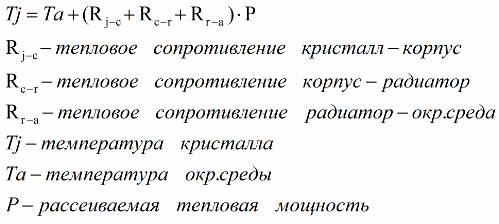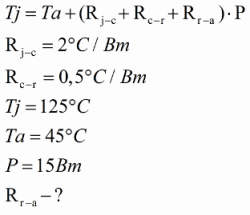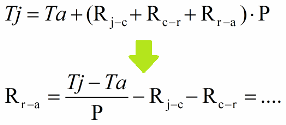Categories: Featured Articles » Practical Electronics
Number of views: 28898
Comments on the article: 0
How to calculate the radiator for a transistor
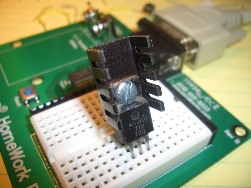 Often, when designing a powerful device on power transistors, or resorting to the use of a powerful rectifier in the circuit, we are faced with a situation when it is necessary to dissipate a lot of thermal power, measured in units, and sometimes tens of watts.
Often, when designing a powerful device on power transistors, or resorting to the use of a powerful rectifier in the circuit, we are faced with a situation when it is necessary to dissipate a lot of thermal power, measured in units, and sometimes tens of watts.
For example, Fairchild Semiconductor's FGA25N120ANTD IGBT transistor, if installed correctly, is theoretically capable of delivering about 300 watts of thermal power through its chassis at a chassis temperature of 25 ° C! And if the temperature of its case is 100 ° C, then the transistor will be able to give 120 watts, which is also quite a lot. But in order for the transistor case to be able to give this heat in principle, it is necessary to provide it with the proper working conditions so that it does not burn out ahead of time.
All power switches are issued in such cases which can be easily installed on an external heat sink - a radiator. Moreover, in most cases, the metal surface of the key or other device in the output housing is electrically connected to one of the terminals of this device, for example, to the collector or to the drain of the transistor.
So, the task of the radiator is precisely to keep the transistor, and mainly its working transitions, at a temperature not exceeding the maximum allowable.
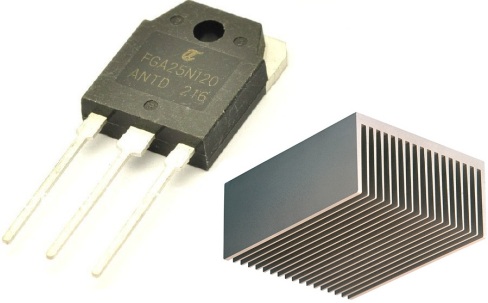
If the case silicon transistor completely metal, then the typical maximum temperature is approximately 200 ° C, if the case is plastic, then 150 ° C. You can easily find data on the maximum temperature for a particular transistor in the datasheet. For example, for FGA25N120ANTD it is better if its temperature does not exceed 125 ° C.
Knowing all the basic thermal parameters, it is easy to choose a suitable radiator. It is enough to find out the maximum temperature of the environment in which the transistor will work, the power that the transistor will have to dissipate, then calculate the transition temperature of the transistor taking into account the thermal resistances of the crystal-case, crocus-radiator, radiator-environment connections, after which it remains to choose a radiator , with which the temperature of the transistor will be at least slightly lower than the maximum allowable.
The most important parameter in the selection and calculation of the radiator is thermal resistance. It is equal to the ratio of the temperature difference on the surface of the thermal contact in degrees to the transmitted power.
When heat is transferred through the heat conduction process, the thermal resistance remains constant, which does not depend on temperature, but depends only on the quality of thermal contact.
If there are several transitions (thermal contacts), then the thermal resistance of the transition, consisting of several consecutive compounds, will be equal to the sum of the thermal resistances of these compounds.
So, if the transistor is mounted on a radiator, then the total thermal resistance during heat transfer will be equal to the sum of thermal resistances: crystal-case, case-radiator, radiator-environment. Accordingly, the crystal temperature is in this case according to the formula:
As an example, consider the case when we need to select a radiator for two transistors FGA25N120ANTD, which will work in a push-pull converter circuit, with each transistor dissipating 15 watts of thermal power, which must be transferred to the environment, i.e. from crystals of transistors through a radiator - to air.
Since there are two transistors, first we find a radiator for one transistor, after which we just take a radiator with twice as much heat transfer area, with half as much thermal resistance (we will use insulating gaskets).
Let our device operate at an ambient temperature of 45 ° C. Let the crystal temperature be kept no higher than 125 ° C. In the datasheet, we see that for the built-in diode the thermal resistance of the crystal-case is greater than the thermal resistance of the crystal-case directly IGBT, and it is equal to 2 ° C / W. This value will be taken into account as the thermal resistance of the crystal-case.
The thermal resistance of the silicone insulating gasket is about 0.5 ° C / W - this will be the thermal resistance of the case-radiator. Now, knowing the dissipated power, the maximum temperature of the crystal, the maximum ambient temperature, the thermal resistance of the crystal-casing and the thermal resistance of the casing-radiator, we find the necessary thermal resistance of the radiator-environment.
So, we need to choose a radiator so that the thermal resistance of the radiator-environment is obtained under the given conditions of 2.833 ° C / W or less. And to what temperature in this case does the radiator overheat compared to the environment?
Take the found thermal resistance at the radiator-environment boundary and multiply by the dissipated power, for our example 15 watts. Overheating will be about 43 ° C, i.e. the temperature of the radiator will be about 88 ° C. Since there will be two transistors in our circuit, it will be necessary to dissipate the power twice as much, which means that you need a radiator with a thermal resistance half as small, that is 1.4 ° C / W or less.

If you do not have the opportunity to choose a radiator with the thermal resistance found, then you can use the good old empirical method - refer to the schedule from the reference book. Knowing the temperature difference between the environment and the radiator (for our example, 43 ° C), knowing the dissipated power (for our example, for two transistors - two of 15 W each), we find the necessary radiator area, that is, the total contact area of the radiator with the ambient air (for our an example - two of 400 cm2).
See also on this topic:Inch * degree / watt - what is this radiator parameter?
See also at bgv.electricianexp.com
:


